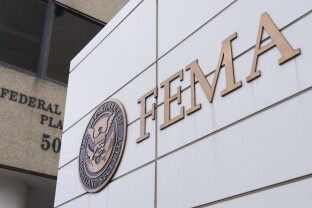A federal judge has temporarily blocked the Trump administration from going forward with its plans to redirect money originally intended for a massive natural disaster resilience program on other priorities.
The preliminary injunction, issued by Judge Richard Stearns in the Massachusetts District Court, prevents the Federal Emergency Management Agency from spending the hundreds of millions of dollars intended for the Building Resilient Infrastructure and Communities program on anything else.
The injunction was granted at the request of 20 Democratic-led states, which sued the Trump administration in mid-July over its cancellation of the BRIC program. Those states, including Pennsylvania, North Carolina, New York and California, were depending on the program to help fund infrastructure projects that would address serious flood risks in populated areas.
“The court is not convinced that Congress vested in the agency any discretion to reallocate funds from the BRIC account,” Stearns wrote in the injunction.
“Given the negligible burden placed on the Government by the requested injunction, it is difficult — if not impossible — for the Government to show that the injunction will cause it any irreparable harm,” the judge later said in a footnote. “Not unexpectedly, in responding to the court’s questioning during the July 31 hearing, Government counsel was unable to articulate any immediate hardship the Government would face given its assurances that no final decision on the termination of BRIC has been made.”
FEMA in April cancelled the BRIC program, calling it “wasteful.” The agency had said previously that it intended to redirect about $800 million in funds for BRIC into the pool of money that goes to paying for a response in the aftermath of a disaster.
But in a court filing over the lawsuit, FEMA said it had not actually made any final plans to end the BRIC program.
The program is hugely popular, with hundreds of communities using the funding every year to address flood and other natural disaster risks. In the last fiscal year, communities applied for more than $5 billion worth of grants, while the agency only had $1 billion available to spend.
Spending on disaster resilience lowers the cost for taxpayers after disasters, giving a return on investment that can vary anywhere from $3 to $14 per $1 spent, depending on the community and the risk, according to multiple studies from insurance providers and the National Institute of Building Sciences.
While the Trump administration has softened its talk of completely eliminating FEMA, the administration has heavily curtailed the agency’s disaster resilience efforts. In addition to canceling the BRIC program, the president has changed the standard process for granting hazard mitigation funds to states after disasters, and FEMA has begun offering other preparedness grants only in the last few weeks, months later than the usual process.
FEMA did not immediately respond to request for comment.
This site is protected by reCAPTCHA, and the Google Privacy Policy and Terms of Service apply. By continuing on NOTUS, you agree to its Terms of Use and Privacy Policy.
Sign in
Log into your free account with your email. Don’t have one?
This site is protected by reCAPTCHA, and the Google Privacy Policy and Terms of Service apply. By continuing on NOTUS, you agree to its Terms of Use and Privacy Policy.
Check your email for a one-time code.
We sent a 4-digit code to . Enter the pin to confirm your account.
New code will be available in 1:00
Let’s try this again.
We encountered an error with the passcode sent to . Please reenter your email.
This site is protected by reCAPTCHA, and the Google Privacy Policy and Terms of Service apply. By continuing on NOTUS, you agree to its Terms of Use and Privacy Policy.


